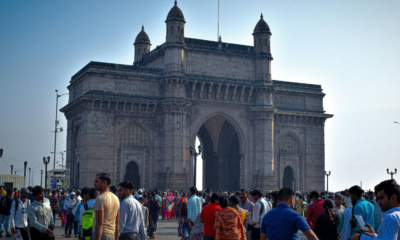Travel Guides & Articles
Kolkata’s Alipore Zoo: Meet giraffes, jaguars and kangaroos in the heart of the city | Travel

When was the last time you visited a zoo with your family?
When you’re raising twin boys, finding ways to tire them out without exhausting yourself is a skill worth having. I’ve learnt that the sweet spot lies in slow-paced outings that are interesting enough to keep them engaged, but gentle enough on my nerves. We often choose zoo visits, lazy boat rides and strolls in leafy parks, and these have become our go-to activities whenever we’re travelling.
So there we were in Kolkata, soaking in the energy of its traffic and old-world charm. The trams rattled by, horse carts waited outside Victoria Memorial, jhal muri sellers worked their magic on the streets, and puchka (the local name for pani puri) vendors popped up on every corner. The local carts, or thelas, were piled high with star fruits and water apples. As February eased into its final days, the drizzle gave way to perfect walking weather. It felt like the right day for the zoo.
First impressions
When I say this is one of the most underrated places to explore in the city, I truly mean it. Over 50 of my local relatives shook their heads, insisting it was not worth a visit and they had not been there at all or many years ago, and Google reviews did not give me much hope either. Still, we decided to give it a shot. We arrived at a slightly worn-out gate, saw the Rs. 50 per adult entry fee, and wondered if the day might disappoint.
On the other side of the ticket counter, it felt like stepping into a secret garden. A beautifully kept lawn with animal-shaped topiary led us towards the real stars of the show. The Alipore Zoological Garden is large, well-maintained and home to an impressive variety of wildlife from India and abroad. We saw zebras, giraffes, rhinoceroses, hippos, kangaroos, jaguars, and birds, including cassowaries, hornbills, exotic parrots, and peacocks.
Five things you might not know about Alipore Zoo, Kolkata
1. Alipore Zoo in Kolkata opened to the public in 1876, making it the oldest formal zoo in India.
2. It covers about 47 acres and uses open-air moated enclosures that resemble natural habitats.
3. The zoo once housed Adwaita, an Aldabra giant tortoise believed to be over 250 years old when it died in 2006.
4. It has been a pioneer in breeding white tigers, reticulated giraffes and the endangered Manipur brow-antlered deer.
5. In 1889, the birth of a Sumatran rhinoceros here marked a rare global achievement in captive breeding.
Why it works
- Enclosures are spacious, with areas where animals can rest away from public view.
- Paved paths, benches and refreshment stalls make it easy to explore comfortably.
- Toilets are located at opposite ends of the zoo for convenience.
- The animals appeared healthy and relaxed, with no signs of stress.
The weather that day was a gift, warm enough for short sleeves yet cool enough to walk for hours without breaking a sweat. We wandered through leafy paths, stopping often to rest on shaded benches, never once feeling rushed or tired. The twins eagerly read every fact on the animal display boards, pointing out details to each other like little wildlife experts.
Their excitement peaked when a dozen giraffes suddenly broke into a graceful gallop across their open enclosure, their hooves kicking up little clouds of dust. Moments later, the deep, guttural roar of a jaguar drew a small crowd, while the kangaroos kept us waiting for a good half hour before casually hopping out, sending a ripple of cheers and camera clicks through the visitors. My son’s verdict in the end, and I quote, was, “ Mom, this is like being at a safari without going to the jungle!”
Getting there and eating nearby
Parking is limited, so taking a cab or Uber is the easiest option. The main gate faces the Taj Bengal, making the approach pleasant and easy to spot. We chose to have lunch before entering, which was a smart move with children. We ate at Somponno, a nearby café serving a Bengali-Chinese take on noodles that was surprisingly good. You will also find plenty of other cafés nearby if you check online maps.
Tips for the best visit
- Set aside at least three hours to see everything comfortably.
- Wear comfortable walking shoes as the grounds are extensive.
- Weekdays are quieter, though you may run into school trips.
- Choose cooler weather to make the walk more pleasant and to see more active animals.
- If visiting with children, go after breakfast or lunch to avoid mid-visit hunger.
India is full of hidden treasures, and the Alipore Zoo is one worth adding to your list. Pair a visit here with a steamer ride across the Hooghly River, some puchka from a local vendor while you get set to take a yellow taxi back across the Howrah Bridge, or an evening at Victoria Memorial with a ride in the horse carriages outside, along with a box of Bengali sweets, and you have the perfect Kolkata day.
Similar articles for you
Tropic of Cancer, one of Bhopal’s underrated gems: Scenic drive you cannot miss
Get vacation-ready! Up to 80% off on top picks for trolley bags
₹2500″>Travel smarter, not harder: Your guide to affordable trolley bags under ₹2500
Alipore Zoo in Kolkata: FAQs
- What is the entry fee for Alipore Zoo?
Entry is Rs. 50 per adult. Children’s tickets are usually cheaper, and there may be different rates on public holidays.
- What are the zoo timings?
The zoo typically opens in the morning and closes in the late afternoon. Check the official website or local listings for exact seasonal timings.
- How long does it take to explore the zoo?
Set aside at least three hours if you want to see all the animals comfortably and include a few rest breaks.
- What is the best way to get there?
Taking a cab or an Uber is the easiest option, as parking is limited nearby. The zoo is right opposite Taj Bengal, which makes it easy to spot.
Disclaimer:At Hindustan Times, we help you stay up-to-date with the latest trends and products. Hindustan Times has an affiliate partnership, so we may get a part of the revenue when you make a purchase. We shall not be liable for any claim under applicable laws, including but not limited to the Consumer Protection Act, 2019, with respect to the products. The products listed in this article are in no particular order of priority.
Travel Guides & Articles
Fatehpur Sikri, India, travel guide: Seven highlights to see

Seven wonders within Fatehpur Sikri, India
This monumental Mughal capital 37 kilometres outside Agra was founded in 1571 but lasted scant decades. The magnificently mournful ruins are one of India’s most underrated sights.
1 Make a grand entrance through Victory Gateway
As you lurch out of Agra, dodging cars and camel carts, your first sight of this ruined city is an immense hilltop gateway, one of the world’s biggest, wobbling like a mirage in the heat. Victory Gateway was built in 1602 from red sandstone and white marble to commemorate Emperor Akbar’s military triumphs, although its Persian inscription warns the world doesn’t last. This by itself qualifies as a mighty monument, and the views are splendid.
2 Pause in admiration inside the mosque
Step through the gateway into the courtyard of the Friday Mosque and you get the first impact of this tremendous ensemble. Everything is built of red sandstone, everything outsized, and yet the decorative detail – window frames, balconies, roof brackets – wonderfully carved. The mosque is one of India’s finest and largest and centres on the tomb of a Sufi, inlaid with mother-of-pearl. Local women come to tie strings on the marble lattice in hope of being granted children.
3 Check out the architecture in the Audience Hall
This gloriously startling building in the royal quarter is where Akbar consulted advisers. The Diwan-i-Khas has wall recesses that served as bookshelves for royal documents and texts. However, your eyes will surely be on the enormous and wildly ornate octagonal pillar of the main hall, which rises from the centre of the room like the handle of an umbrella and props up an elevated walkway that resembles the balcony in an opera house.
4 Look up in the Imperial Treasury
Fatehpur Sikri shows wide Hindu, Islamic and Persian influences but this genius building next to the Audience Hall takes inspiration from Jain temple architecture and decorative sculpture. Stone safes are concealed in the walls, but gaze up: the brackets that hold up the ceiling are embellished with mythical elephant-headed sea monsters, said to guard treasures in the depths of the ocean. In the fields behind, don’t miss the odd-looking spiky tower erected in memory of Akbar’s beloved elephant Hiran.
5 Enjoy the faded frescoes in Mariam’s House
The harem complex has several fine pavilions, some showing Turkish influences and others covered with depictions of swans and horses. The carvings and fretwork are so fine in places you could mistake sandstone for wood. If you’re pressed for time, head straight to Mariam’s House, perhaps the best example. As a bonus, it has bright and sometimes surreal gold-tinted frescoes – look out for the diaphanous woman riding a gigantic parrot.
6 Wander through the other imperial quarters
This is the most impressive part of Fatehpur Sikri, erupting in columns, latticed screens and elaborately decorated architectural elements, and graced with ornamental pools and clipped gardens. Persian verses loop across the emperor’s bedroom or House of Dreams, although judging from his innumerable concubines Akbar spent scant time on sleep. The pool below the elevated kiosk cooled the bedchamber. This is just one of numerous buildings that might take an hour or two to admire.
7 Close your guidebook and get lost
Fatehpur Sikri was planned in the smallest detail: servants’ quarters, lavatory blocks, fountain drainage, masonry rings to hold silk canopies for courtyard shading. Take time to inspect the detail and soak up the melancholy magnificence away from the main visitor axis. Birds wheel overhead and squirrels sun themselves on walls. In the late afternoon the sandstone turns crimson, then orange and subtle pink before the light fades on this abandoned city of lost dreams.
The writer travelled as a guest of Incredible India incredibleindia.gov.in and Malaysia Airlines malaysiaairlines.com
Sign up for the Traveller Deals newsletter
Get exclusive travel deals delivered straight to your inbox. Sign up now.
Traveller Guides
From our partners
Travel Guides & Articles
Heavy rain alert in Delhi–Gurugram: IMD issues an orange alert; travel and safety advisory |

In a recent update, Delhi and its surrounding NCR cities, including Gurugram, Noida, and Faridabad, have received intense rainfall. The India Meteorological Department (IMD) has issued an orange alert for Delhi while a warning of very heavy rainfall and thunderstorms has been issued for Gurugram.Keeping the current situation in view, the District Disaster Management Authority has issued a travel advisory for Gurugram for 2nd September 2025. It reads:On September 1, 2025, Gurugram recorded over 100 mm of rainfall between 3 PM and 7 PM. The India Meteorological Department (IMD) has issued an Orange Alert, forecasting heavy to very heavy rainfall on September 2, 2025.In light of this warning:Corporate offices and private institutions in Gurugram district are advised to ask employees to work from home.
All schools in the district are directed to conduct online classes on September 2, 2025.On the other hand, Delhi too is experiencing non-stop rains which have caused waterlogging and long traffic across roads. Authorities are closely monitoring the Yamuna River too, which is expected to rise close to the danger mark of 206 metres on Tuesday. Low-lying areas are particularly vulnerable to flooding.India Meteorological Department forecastIn the present scenario, the India Meteorological Department (IMD) has issued an orange alert for Delhi for heavy rainfall. Similar alerts have been issued for NCR regions including Noida, Faridabad, and Gurugram. A yellow warning has been issued for Ghaziabad.Not only this, IMD has cautioned that northern India may experience heavy rainfall at least until September 5 especially for Uttarakhand, Himachal Pradesh, and Punjab which are under red and orange alerts.Travel disrupted, airlines issue advisoryAirlines such as IndiGo, Air India, SpiceJet, and Akasa too have issued warnings and advised people of possible delays and cancellations due to poor visibility. Passengers are advised to check flight status before leaving the house.Advisory
It is advised to avoid flood-prone zones, underpasses, and Yamuna ghats.Use public transport.For those in Gurugram, work from home is strongly recommended on September 2 as safety of people is more important.Keep a check on official IMD and local weather updates before planning anything.
Travel Guides & Articles
National parks in Northeast India for rarest wildlife experiences

Northeast India, with its lush forests, rugged mountains, and pristine rivers, is a biodiversity hotspot offering unparalleled opportunities to encounter some of the world’s rarest wildlife. The region’s national parks and sanctuaries protect unique ecosystems and endangered species like the one-horned rhinoceros, red panda, clouded leopard and more. From Manas National Park and Tiger Reserve in Assam to Keibul Lamjao National Park in Manipur, find out what makes these national parks so unique, and what rare creatures these parks have in store for visitors.
-

 Business3 days ago
Business3 days agoThe Guardian view on Trump and the Fed: independence is no substitute for accountability | Editorial
-
Tools & Platforms3 weeks ago
Building Trust in Military AI Starts with Opening the Black Box – War on the Rocks
-

 Ethics & Policy1 month ago
Ethics & Policy1 month agoSDAIA Supports Saudi Arabia’s Leadership in Shaping Global AI Ethics, Policy, and Research – وكالة الأنباء السعودية
-

 Events & Conferences3 months ago
Events & Conferences3 months agoJourney to 1000 models: Scaling Instagram’s recommendation system
-

 Jobs & Careers2 months ago
Jobs & Careers2 months agoMumbai-based Perplexity Alternative Has 60k+ Users Without Funding
-

 Funding & Business2 months ago
Funding & Business2 months agoKayak and Expedia race to build AI travel agents that turn social posts into itineraries
-

 Education2 months ago
Education2 months agoVEX Robotics launches AI-powered classroom robotics system
-

 Podcasts & Talks2 months ago
Podcasts & Talks2 months agoHappy 4th of July! 🎆 Made with Veo 3 in Gemini
-

 Mergers & Acquisitions2 months ago
Mergers & Acquisitions2 months agoDonald Trump suggests US government review subsidies to Elon Musk’s companies
-

 Podcasts & Talks2 months ago
Podcasts & Talks2 months agoOpenAI 🤝 @teamganassi





















